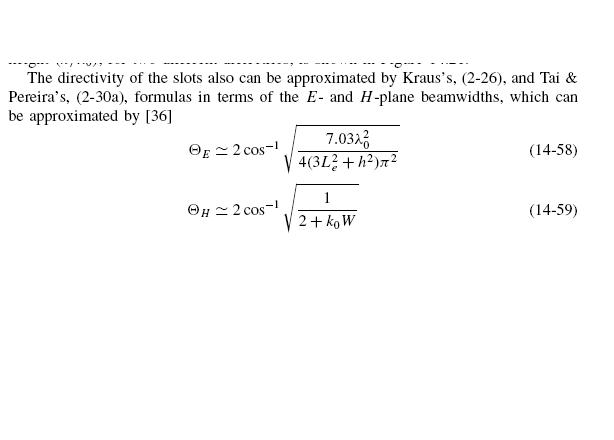beamwidth calculation
You have to do an antenna pattern measurement in a Open Space site, or Anechoic Chamber.
Using a test antenna and a rotary table rotate in degrees steps your microstrip antenna and measure the gain for each step.
Usually beamwidth is defined for +/- 3dB from a specific direction.
Hi Vfone,
Thanks for your reply.
I'm aware of these antenna measurements.
But my question was how to calculate beamwidth from patch dimension? Just like calculating gain from effective aperature area.
You cannot calculate with accuracy, only you can simulate using a 3D antenna simulator, as HFSS, CST, Zeland, etc.
There is a common "rule" for 3 dB beamwidth. It starts breaking down for low gain antennas (6-8 dBi) so use it with caution.
BWdeg=65/(D/λ)
where D is the dimension in the plane where you are estimating beamwidth and λ is, of course, wavelength in the same units.
The empirical formula BeamWidth = 70λ/D, is valid for Parabolic Antennas and not for Microstrip Antennas, as the original post is asking.
Length (L) of the antenna also comes in to the picture while calculating BW.
But in above mention formula Length is not mentioned.
The rule cited is an approximation. That is the intent of my comment about using it cautiously for less directive antennas. It is a rule of thumb and should not be taken to be an exact prediction. Do we really need to debate the constant 65 vs 70?
The parameter, D is the antenna length. You can replace the D with L and not lose generality.
Effect of width of the antenna in Beamwidth?
In general, beamwidth decreases with increasing size and frequency. There are exceptions, but this is the general trend.
yea, like Azulykit said,
the beamwidth is proportional to the ratio lambda to dimension,
means: if lambda large (low freq.) beamwidth is broad (low gain)
if lambda small (high freq.) beamwidth is narrow (high gain)
and
if dimension small, beamwidth is broad (low gain)
if dimension large, beamwidth is narrow (high gain)
however, more important is the ratio. It means
if you use high frequency and very small antenna, there is no guarantee
that the beamwidth is narrow
Thanks guys for your valuable information.
I read from one book
Horizontal Beamwidth = 115λ/L
Vertical Beamwidth=50λ/L
These are approximate formulas.
I suggest you run down a copy of Silver's book on antennas. He discusses the effect on beamwidth from various apertures in detail. If you really want to go into it that would be a place to start.
The material here does not really give you a picture of the unspoken assumptions behind the various rules.
I now think I probably should not have raised the subject in the first place.
Hi, would you have the references of the book from which you found the said equations? All the books I have picked up require complicated calculations and I just want to do 1st hand approximations --- I'd like to be able to read up that book
Thanks
yeah, quotation with reference is much convincible.
Hi, have you book:
Constantine A.Balanis: Antenna Theory Third edition - Analysis and design ?
There is on page 842:

Hi,
check also chapter 2 (Link analysis) of "Satellite Communications Link", maral Bousquet third edition.
You find easy formulas.
Pay attention also to the depointing error..
Hope it helps.
Regards,
Lupin
hye everyone.. i got 1 problem and its abit confuse about the antenna beamwidth and antenna beam solid angle..
so, for the question,
Find the beamwidth of an ideal antenna having gain of 35dB.
so from gain we can obtain beam solid angle which is Ωb. is this solid angle in steradian is equal to beamwidth? sory for that simple question.. can someone take me out from this confusion..
